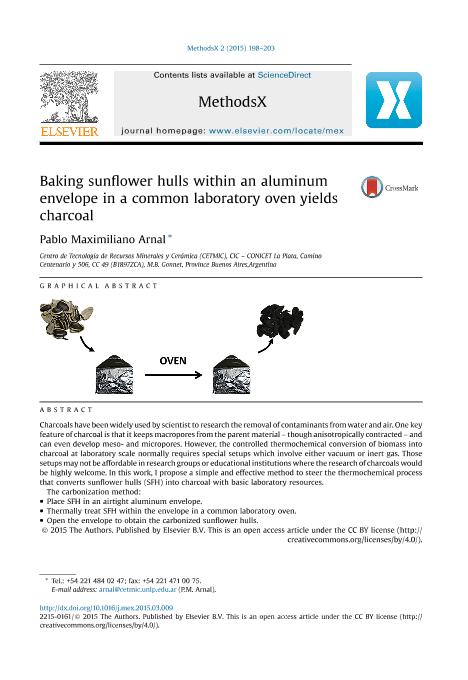Artículo
Baking sunflower hulls within an aluminum envelope in a common laboratory oven yields charcoal
Fecha de publicación:
04/2015
Editorial:
Elsevier
Revista:
MethodsX
ISSN:
2215-0161
Idioma:
Inglés
Tipo de recurso:
Artículo publicado
Clasificación temática:
Resumen
Charcoals have been widely used by scientist to research the removal of contaminants from water and air. One key feature of charcoal is that it keeps macropores from the parent material - though anisotropically contracted - and can even develop meso- and micropores. However, the controlled thermochemical conversion of biomass into charcoal at laboratory scale normally requires special setups which involve either vacuum or inert gas. Those setups may not be affordable in research groups or educational institutions where the research of charcoals would be highly welcome. In this work, I propose a simple and effective method to steer the thermochemical process that converts sunflower hulls (SFH) into charcoal with basic laboratory resources. The carbonization method: Place SFH in an airtight aluminum envelope. Thermally treat SFH within the envelope in a common laboratory oven. Open the envelope to obtain the carbonized sunflower hulls.
Palabras clave:
Aluminum Foil
,
Biomass
,
Carbonization
,
Charcoal
,
Sunflower Hull
Archivos asociados
Licencia
Identificadores
Colecciones
Articulos(CETMIC)
Articulos de CENTRO TECNOL.DE REC.MINERALES Y CERAMICA (I)
Articulos de CENTRO TECNOL.DE REC.MINERALES Y CERAMICA (I)
Citación
Arnal, Pablo Maximiliano; Baking sunflower hulls within an aluminum envelope in a common laboratory oven yields charcoal; Elsevier; MethodsX; 2; 4-2015; 198-203
Compartir
Altmétricas




